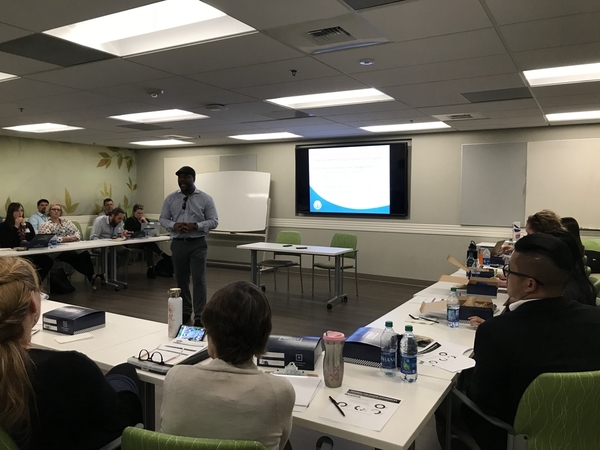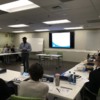On May 22, I had the opportunity to experience a presentation by DeAngelo Mack on the WellSpace Health Sacramento Violence Intervention Program, Trauma and ACEs. The presentation was at Kaiser Sacramento and was directed to residents in the organization.
I have worked with @DeAngelo Mack, @Chris Cooper and @Esmeralda Huerta through Resilient Sacramento for the past few years and have admired their work in the community, this was the first opportunity I had to attend a formal presentation on the Sacramento Violence Intervention Program.
The WellSpace Health Sacramento Violence Intervention Program (SVIP) began in June 2010 after a particularly violent year in 2009 in Sacramento. Partners in the South Sacramento community realized that youth were being violently injured, being patched up and sent back into the community. The City of Sacramento, WellSpace Health and Kaiser South Sacramento joined together to create SVIP which grew out of the “Caught in the Crossfire Model” from Youth Alive in Oakland, California. Youth Alive has been in operation for over 25 years and was the first organization in the nation to implement a hospital based intervention program.
Hospital based intervention programs seek to make contact with youth and their families who have been involved in violent crime with the goals to prevent retaliation, reinjury and also decrease arrest rates. When a person between the ages of 15-26 is admitted to the hospital with a gunshot, stab wound or assault, the SVIP team gets a call. They meet with the youth and family at the hospital bedside to assist with de-escalation, resources and services. For the next six months to a year, they work with the youth, providing a stable caring relationship which has been proven to dramatically reduce re-injury.
In eight years, the SVIP has worked with over 700 families. Their success rate is 98%. I’ll say that again...in the 10 years that SVIP has been operating in Sacramento, they have a 98% success rate of youth not being re-injured, retaliating or being arrested.
But the SVIP does more than just offer support, resources and services. According to Program Coordinator, DeAngelo Mack he had an “ah-ha” moment a few years ago when in conversation with the Associate Director of the RYSE Center in Richmond, California; @Kanwarpal Dhaliwal. (If you have not had the opportunity to check out the RYSE Center’s amazing work with youth, I encourage you to do so!) Dhaliwal and Mack were in conversation about the program when she asked him, “ Are your clients liberated?” This set into motion a shift in the program with a focus on mental health and also confronting structural and sociocultural oppression as well as generational and historical trauma. Mack acknowledges that violence in our society is a taught mechanism which continues to be perpetuated.
One strategy to deal with community violence as a public health issue. Mack asserts that our treatment approaches to community violence should resemble those we use to treat infectious diseases. He referenced Dr. Nadine Burke Harris’ new book The Deepest Well: Healing the Long-Term Effects of Childhood Adversity and how we need to treat the cause of these issues and not just the symptoms.
SVIP seeks to not only heal those who have experienced violence but also to interrupt the next event and the transmission of violent activity to others in the community or to other generations. Part of this solution is asking ourselves, “Why are youth so prone to anger?” Mack cites the issue of respect as a cause. Youth of color are constantly under attack in our society through toxic stress as a result of racism, structural, and historical trauma. When they finally find ways to gain respect, they will use any means possible to protect this respect. This respect may come in the form of street credibility or gang affiliation that in some cases can lead to violence. SVIP and the RYSE Center have made amazing strides in working with youth to empower them, show them respect. Mack and his team at SVIP operate from a place of love, hope, and sacred rage to build beloved community. SVIP has very close connections to the RYSE Center and utilizes many of their foundational principles of interacting with youth and community. Both organizations work with youth to avoid turning rage inward, but instead utilize that rage to create change. The RYSE Center has constructed and implements the following principles that create Beloved Community:
- We lead with love and rage
- We prioritize relationships
- We acknowledge injustice and harm
- We take risks
- We stop to acknowledge grief and loss
- We practice collective care
- We encourage and support self-care and healing
- We honor resilience and resistance
- We celebrate and have fun
- We keep learning
Through it all, Mack and his team at SVIP operate from a place of love, hope and sacred rage. “It is amazing what can happen out of tragedy,” he says. Seeing communities come together in the face of trauma. He cited the murder of Stephon Clark in Sacramento as an example. This heinous tragedy has allowed us to come together to not only challenge police brutality, but to take a look at crimes within our communities and how we can work collectively to support each other. Concurrently we need to continue to examine the following questions, “How does race affect our community health issues? What does structural oppression, white supremacy and white privilege do to our communities and our health? And how do we cope?”
To conclude the presentation, Mack discussed vicarious trauma and burnout. For those who work with individuals experiencing high levels of trauma it is important to make sure that we support each other and take care of ourselves. He led the group through a guided imagery exercise and also shared a self-care playfulness plan that the SVIP team employs. For the playfulness plan, the team shares with each other what brings them joy and happiness. When a member of the team is displaying signs of stress or burnout, they suggest taking some time to execute their playfulness plan, like going to the movies or spending some time to be outside or with friends. This has helped to create a culture of support that nourishes the team as they work within the community. Mack noted, “We love what we do. It is extremely taxing but also extremely rewarding. We have to share our feelings to do this work.”





Comments (2)